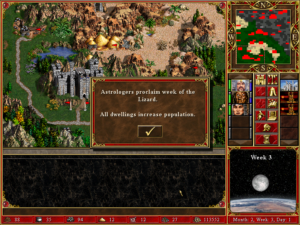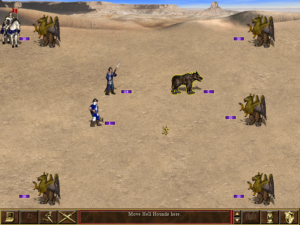Heroes Chronicles: Starting Over
 So, I decided to start over from the beginning in Conquest of the Underworld. To explain why, I’ll have to desribe the game mechanics a little.
So, I decided to start over from the beginning in Conquest of the Underworld. To explain why, I’ll have to desribe the game mechanics a little.
In the Heroes of Might and Magic system, everything that you do outside of the cities you control is done through entities called “heroes”. Heroes have various stats and skills, can wear magic items to affect those stats and skills, and improve with experience like a character in an RPG, but they don’t participate in combat directly. Instead, they gather troops and creatures under their command.
Creatures are produced every seven turns — every week of gametime — in cities and certain free-standing structures. But they can’t do anything on their own. Any creatures that you recruit in a city will simply wait there and defend it until a hero scoops them up and carries them away. It’s useful to think of them as wargaming minis that the heroes carry around in a box.
Now, the kind and number of creatures that a city can produce is determined by the structures that have been built there. For example, in order to produce Griffins, a city must have a Griffin Tower. Turn it into an Upgraded Griffin Tower and you can produce Royal Griffins, which are stronger and faster. Build a Griffin Bastion as well and you can get an additional three griffins per week. But it takes time and money to build these things. By the time a city can produce the best units in any quantity, the action has moved far away. Getting your troops to the front as quickly as possible is a big part of the strategy of the game.
One of the basic techniques is to use a “bucket brigade” — a string of heroes stretching from the city to the front, positioned a day’s ride away from each other, ready to pass that box of minis all the way from the castle to the hero who needs them. In this way, troops can travel arbitrary distances in a single turn. But hiring heroes costs money, even if you’re going to just use them as delivery boys, and setting up a bucket brigade takes some time and effort, especially when you suddenly have to shift it to point in a different direction.
Another thing that helps a lot is that some cities — the “inferno” types, the ones that produce demons and hellhounds and the like — can build Castle Gates. Heroes can travel instantly between any two cities with Castle Gates. But these are expensive and not likely to get built until late, and, as I said, only help for transporting troops between Inferno cities. While this scenario has more Inferno cities than may be regarded as typical, there are also an awful lot of Castle (knight-type troops) and Necropolis (undead-types).
What I have just learned is that there’s a spell called Town Portal that could help a lot. In its basic form, it teleports a hero to the nearest friendly city, but a hero with Advanced Earth Magic can use it to teleport to any friendly city. Thus, it is really useful to have the Earth Magic skill. And there’s a seer back on level 1 who teaches this skill, but I ignored it, because you have a limited number of skill slots and I thought I had more important things to learn.
Well, now I know better.
 Comments(2)
Comments(2)